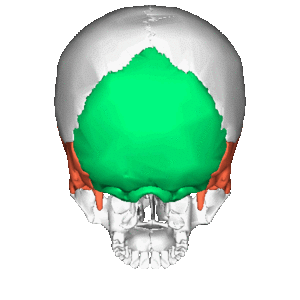Introduction
The skull consist of 22 bones which can be subdivide into 8 cranial bones and 14 facial bones. The latin word for skull is cranium.
The main function of the skull bones along with the surrounded meninges, is to provide protection and structure.[1] Protection to the brain (cerebellum, cerebrum, brainstem) and orbits. Structurally it provides as an anchor for tendinous and muscular attachments of the muscles of the scalp and face. The skull also protects various nerves and vessels that feed and innervate the brain, fascial muscles and skin.
Cranial bones
- Fontal bone
- Parietal bone (2)
- Temporal bone (2)
- Occipital bone
- Sphenoid bone
- Ethmoid bone[1]
Sutures
Strong, fibrous, elastic bands of tissues that binds/ connect the cranial bones together.
- Coronal suture: Junction between the frontal and two parietal bones. The coronal suture lies in the coronal plane.
- Sagittal suture: Junction between two parietal bones. The sagittal suture lies in the sagittal plane.
- Squamous suture: Junction between the temporal and parietal bones.
- Lambdoid suture: Junction between the parietal bones and the occipital bones.
- Pterion: Junction of the frontal, parietal and temporal bones in the lateral aspect of the skull.
Facial bones
- Nasal conchae (2)
- Nasal bones (2)
- Maxilla bones (2)
- Palatine bones (2)
- Lacrimal bones (2)
- Zygomatic bones (2)
- Mandible
- Vomer[2]
Blood supply
The skull and its contents is mainly provided with oxygenated blood from the common carotid artery, whereas the remainder of blood supply comes from the vertebral artery.
Nerve supply
The base of skull has numerous foraminas that allow the entry lot of vessels and nerves, including the cranial nerves.
- The Optic nerve and Ophthalmic artery passes through the optic nerve canal.
- Superior orbital fissure transmits the Oculomotor nerve, Trochlear nerve, Ophthalmic branch of the trigeminal nerve and the Abducens nerve.
- Internal carotid artery enters through the carotid canal.
- The mandibular branch of the Trigeminal nerve exits the skull through the Foramen rotunda.
- The middle meningeal artery passes through the Foramina spinosum.
- Foramina magnum: allows the spinal cord through the base of skull into the spinal canal of the vertebral column.[2]
Clinical significance
Epidural haematoma
Base of skull fracture
Craniosnostosis
Resources
References
- ↑ 1.01.1 Morton DA, Foreman K, Albertine KH. eds. ‘The Big Picture: Gross Anatomy, 2e’ New York, NY: McGraw-Hill; .http://accessmedicine.mhmedical.com.uplib.idm.oclc.org/content.aspx?bookid=2478§ionid=202020790. Accessed April 08, 2019.
- ↑ 2.02.1 Anderson BW, Al Kharazi KA. Anatomy, Head and Neck, Skull. [Updated 2019 Feb 8]. In: StatPearls [Internet]. Treasure Island (FL): StatPearls Publishing; 2019 Jan-. Available from: https://www.ncbi.nlm.nih.gov/books/NBK499834/
- ↑ Gaylene Ewing. Cranial bones. Available from: ↑ Gaylene Ewing. Facial bones. Available from: function gtElInit() { var lib = new google.translate.TranslateService(); lib.setCheckVisibility(false); lib.translatePage('en', 'pt', function (progress, done, error) { if (progress == 100 || done || error) { document.getElementById("gt-dt-spinner").style.display = "none"; } }); }
Ola!
Como podemos ajudar?


